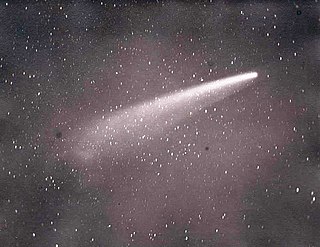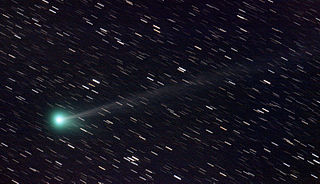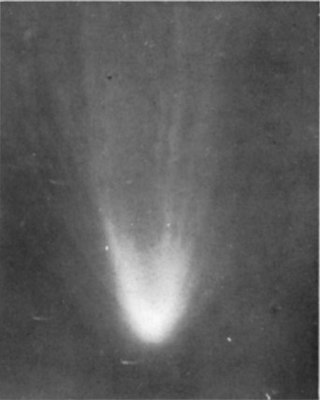
Comet Hale–Bopp is a comet that was one of the most widely observed of the 20th century and one of the brightest seen for many decades.

Comet Hyakutake is a comet discovered on 31 January 1996. It was dubbed the Great Comet of 1996; its passage to within 0.1 AU (15 Gm) of the Earth on 25 March was one of the closest cometary approaches of the previous 200 years. Reaching an apparent visual magnitude of zero and spanning nearly 80°, Hyakutake appeared very bright in the night sky and was widely seen around the world. The comet temporarily upstaged the much anticipated Comet Hale–Bopp, which was approaching the inner Solar System at the time.

Comet Ikeya–Seki, formally designated C/1965 S1, 1965 VIII, and 1965f, was a long-period comet discovered independently by Kaoru Ikeya and Tsutomu Seki. First observed as a faint telescopic object on September 18, 1965, the first calculations of its orbit suggested that on October 21, it would pass just 450,000 km (280,000 mi) above the Sun's surface, and would probably become extremely bright.

The Great Comet of 1882 formally designated C/1882 R1, 1882 II, and 1882b, was a comet which became very bright in September 1882. It was a member of the Kreutz Sungrazers, a family of comets which pass within 1 R☉ of the Sun's photosphere at perihelion. The comet was bright enough to be visible next to the Sun in the daytime sky at its perihelion. The comet made its closest approach to Earth on 16 September 1882 at 0.99 AU and then came to perihelion the next day on 17 September.

Comet Arend–Roland was discovered on November 8, 1956 by Belgian astronomers Sylvain Arend and Georges Roland on photographic plates. As the eighth comet found in 1956, it was named Arend–Roland 1956h after its discoverers. Because it was the third comet to pass through perihelion during 1957, it was then renamed 1957 III. Finally, it received the standard IAU designation C/1956 R1 (Arend–Roland), with the "C/" indicating that it was a non-periodic comet and the "R1" showing that it was the first comet reported as discovered in the half-month designated by "R". The last is equivalent to the period September 1–15.

Comet Pereyra was a bright comet which appeared in 1963. It was a member of the Kreutz Sungrazers, a group of comets which pass extremely close to the Sun.

The Great Comet of 1861, formally designated C/1861 J1 and 1861 II, is a long-period comet that was visible to the naked eye for approximately 3 months. It was categorized as a great comet—one of the eight greatest comets of the 19th century.

C/1680 V1, also called the Great Comet of 1680, Kirch's Comet, and Newton's Comet, was the first comet discovered by telescope. It was discovered by Gottfried Kirch and was one of the brightest comets of the seventeenth century.

The Eclipse Comet of 1948, formally known as C/1948 V1, was an especially bright comet discovered during a solar eclipse on November 1, 1948. Although there have been several comets that have been seen during solar eclipses, the Eclipse Comet of 1948 is perhaps the best-known; it was however, best viewed only from the Southern Hemisphere.

Comet Pojmański is a non-periodic comet discovered by Grzegorz Pojmański on January 2, 2006 and formally designated C/2006 A1. Pojmański discovered the comet at Warsaw University Astronomic Observatory using the Las Campanas Observatory in Chile as part of the All Sky Automated Survey (ASAS). Kazimieras Cernis at the Institute of Theoretical Physics and Astronomy at Vilnius, Lithuania, located it the same night and before the announcement of Pojmański's discovery, in ultraviolet images taken a few days earlier by the SWAN instrument aboard the SOHO satellite. A pre-discovery picture was later found from December 29, 2005.

Comet McNaught, also known as the Great Comet of 2007 and given the designation C/2006 P1, is a non-periodic comet discovered on 7 August 2006 by British-Australian astronomer Robert H. McNaught using the Uppsala Southern Schmidt Telescope. It was the brightest comet in over 40 years, and was easily visible to the naked eye for observers in the Southern Hemisphere in January and February 2007.

Comet Lulin is a non-periodic comet. It was discovered by Ye Quanzhi and Lin Chi-Sheng from Lulin Observatory. It peaked in brightness at magnitude between +4.5 and +5, becoming visible to the naked eye, and arrived at perigee for observers on Earth on February 24, 2009, and at 0.411 AU from Earth.

Comet C/2009 F6 (Yi–SWAN) is a non-periodic comet which appeared in March 2009.

C/2009 R1 (McNaught), one of more than fifty comets known as Comet McNaught, is a non-periodic comet discovered by British-Australian astronomer Robert H. McNaught on September 9, 2009, using the Uppsala Southern Schmidt Telescope at Siding Spring Observatory in New South Wales, Australia. The discovery was confirmed the same day at the Optical Ground Station telescope at Tenerife. After the discovery, earlier images of the comet were found from July 20, August 1, and August 18, 2009. It is believed C/2009 R1 will leave the Solar System permanently.

Comet Beljawsky is also known as 1911 IV and 1911g according to the naming conventions at the time. The comet was discovered by the Russian astronomer Sergei Ivanovich Beljawsky September 29, 1911 and shortly thereafter it was independently seen by four or five other observers in the United States and probably by others throughout the world. At the time it was discovered, the comet was near to the Sun which made observations difficult. However, several days after discovery it was a naked-eye object for a few days in the morning sky and later, after perihelion, as an evening object. It faded rapidly, becoming visible only in telescopes and was last seen on February 17, 1912. The comet sported a tail 8 to 10 degrees in length. In mid-October, the comet was visible in the evening sky together with another bright comet, C/1911 O1 Brooks.

C/2014 Q2 (Lovejoy) is a long-period comet discovered on 17 August 2014 by Terry Lovejoy using a 0.2-meter (8 in) Schmidt–Cassegrain telescope. It was discovered at apparent magnitude 15 in the southern constellation of Puppis. It is the fifth comet discovered by Terry Lovejoy. Its blue-green glow is the result of organic molecules and water released by the comet fluorescing under the intense UV and optical light of the Sun as it passes through space.

C/2019 Y4 (ATLAS) was a comet with a near-parabolic orbit discovered by the ATLAS survey on December 28, 2019. Early predictions based on the brightening rate suggested that the comet could become as bright as magnitude 0 matching the brightness of Vega. It received widespread media coverage due to its dramatic increase in brightness and orbit similar to the Great Comet of 1844, but on March 22, 2020, the comet started disintegrating. Such fragmentation events are very common for Kreutz Sungrazers. The comet continues to fade and did not reach naked eye visibility. By mid-May, comet ATLAS appeared very diffuse even in a telescope. C/2019 Y4 (ATLAS) has not been seen since May 21, 2020.

C/2021 A1 (Leonard) was a long period comet that was discovered by G. J. Leonard at the Mount Lemmon Observatory on 3 January 2021 when the comet was 5 AU (750 million km) from the Sun. It had a retrograde orbit. The nucleus was about 1 km (0.6 mi) across. It came within 4 million km (2.5 million mi) of Venus, the closest-known cometary approach to Venus.

C/2022 E3 (ZTF) is a non-periodic comet from the Oort cloud that was discovered by the Zwicky Transient Facility (ZTF) on 2 March 2022. The comet has a bright green glow around its nucleus, due to the effect of sunlight on diatomic carbon and cyanogen. The comet's systematic designation starts with C to indicate that it is not a periodic comet, and "2022 E3" means that it was the third comet to be discovered in the first half of March 2022.






















